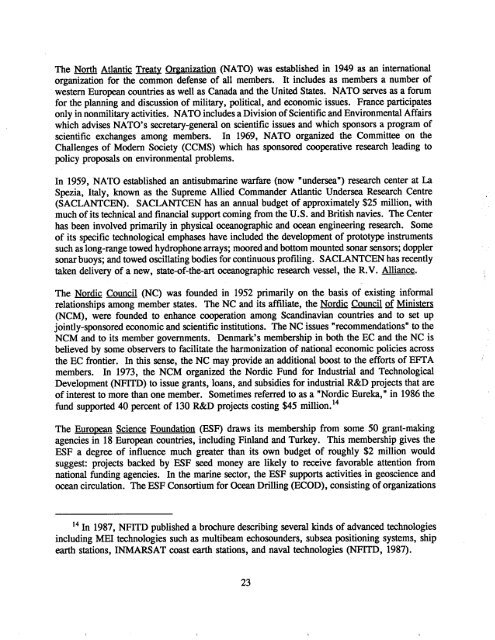WHOI-90-52
WHOI-90-52
WHOI-90-52
You also want an ePaper? Increase the reach of your titles
YUMPU automatically turns print PDFs into web optimized ePapers that Google loves.
The North Atlantic Treaty Ort:anization (NATO) was established in 1949 as an international<br />
organization for the common defense of all members. It includes as members a number of<br />
western Europe countres as well as Canada and the Unite States. NATO serves as a forum<br />
for the planning and discussion of milta, politica, and ecnomic issues. Frace parcipates<br />
only in nonmilta activities. NATO includes a Division of Scientific and Environmenta Affairs<br />
which advises NATO's sereta-genera on scientific issues and which sponsors a program of<br />
scientific exchanges among members. In 1969, NATO organize the Committe on the<br />
Challenges of Modern Society (CCMS) which has sponsored cooperative resech leading to<br />
policy proposas on environmenta problems.<br />
In 1959, NATO established an antisubmarne warfare (now "underse") resech center at La<br />
Spezia, Itay, known as the Supreme Alled Commander Atlantic Underse Resech Centre<br />
(SACLANTCEN). SACLANTCEN has an annua budget of approximately $25 milion, with<br />
much of its technica and financial support coming from the U.S. and British navies. The Center<br />
has been involved primarly in physica ocographic and oc engineering resech. Some<br />
of its speific tehnologica emphases have included the development of prototyp instruments<br />
such as long-range towed hydrophone arays; moored and bottom mounted sonar sensors; doppler<br />
sonar buoys; and towed oscilating boies for continuous profiling. SACLANTCEN has recently<br />
taen delivery of anew, state-of-the-ar ocographic resech vessel, the R. V. Allance.<br />
The Nordic Council (NC) was founded in 19<strong>52</strong> primarly on the basis of existing informal<br />
relationships among member states. The NC and its affiliate, the Nordic Council of Ministers<br />
(NCM), were founded to enhance coperation among Scadinavian countres and to set up<br />
jointly-sponsored economic and scientific institutions. The NC issues "recommendations" to the<br />
NCM and to its member governments. Denmark's membership in both the EC and the NC is<br />
believed by some observers to facilitate the harmonization of national economic policies across<br />
the EC frontier. In this sense, the NC may provide an additional boost to the efforts of EFT A<br />
members. In 1973, the NCM organized the Nordic Fund for Industral and Technologica<br />
Development (NIT) to issue grants, loans, and subsidies for industral R&D projects that are<br />
of interest to more than one member. Sometimes referred to as a "Nordic Eureka," in 1986 the<br />
fund support 40 percent of 130 R&D projects costing $45 milion.14<br />
The Europe Science Foundation (ESF) draws its membership from some 50 grant-makng<br />
agencies in 18 Europe countres, including Finland and Turkey. This membership gives the<br />
ESF a degree of influence much greater than its own budget of roughly $2 millon would<br />
suggest: projects backed by ESF se money are likely to recive favorable attention from<br />
national funding agencies. In the marne setor, the ESF supports activities in geoscience and<br />
oc circulation. The ESF Consortium for Oc Drillng (ECOD), consisting of organizations<br />
14 In 1987, NFITD published a brochure describing severa kinds of advance tehnologies<br />
including MEI technologies such as multibeam echosounders, subse positioning systems, ship<br />
eah stations, INMARSAT coast ea stations, and naval tehnologies (NIT, 1987).<br />
23
















